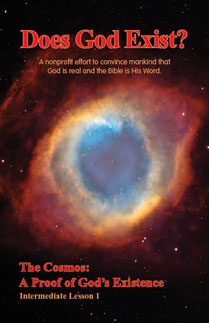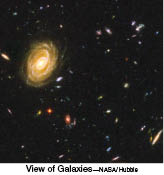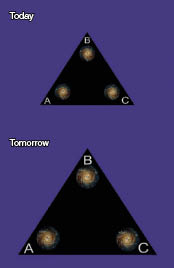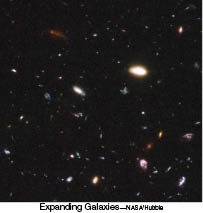DOES GOD EXIST?
Christian Evidences Course
Intermediate Course Lesson 1
This is the first lesson of the online version of the Intermediate Course offered by the Does God Exist? program. This is one of two courses written by John N. Clayton, a former atheist. He came to believe in the Bible as God's Word through his attempts to show it scientifically incorrect. Mr. Clayton was a public school teacher of physics and the earth sciences, retiring after 41 years of teaching. He is a graduate of Indiana University (B.S., M.S.) and the University of Notre Dame (M.S.).
This Intermediate Course is written at a college freshman level. The objectives of this and the Basic Course are (1) to provide a foundation that will refute atheism and deal with challenges to faith; (2) to provide up-to-date, logical, and factual data so that students can answer questions that tend to disturb them in trying to deal with their friends and the world in which they live; and (3) to provide teachers with a wide-range, accurate, open-ended method of teaching this area of great concern. Information on the Basic Course (written at a 4.8 grade level) can be found in our catalog.
This course was place online in order to facilitate a wider and easier access to the course. Here is how it works: Starting with lesson 1, read the required materials (all materials are provided online) and then answer the question sheet provided with each lesson. The easiest way to do this is copy and paste the questions to a word processing program (Word, WordPerfect, Notepad, etc.). Once you finish answering the questions, e-mail the questions/answers to John N. Clayton as a text e-mail, NOT as an attachment or HTML format. We will not accept any e-mail containing attachments. Leave spaces between each question and answer. The answers will be graded and commented on and returned to you. Then you may proceed to the next lesson.
This course is a revision of the original intermediate course that was placed online by Darrick Dean with the permission of the Does God Exist? program. All course materials © John N. Clayton. Report any technical mistakes or errors with the pages to marcusen@michiana.org.
IF YOU NEED TO CONTINUE the course with lessons beyond lesson 1, go to this page and select the lesson you want to do.
Lesson 1
THE COSMOS: A PROOF OF GOD'S EXISTENCE
 To The Student
To The Student
The purpose of this course is to show that you can intellectually, logically, rationally, and scientifically believe in God and in the Bible as His Word. We do not present this course with the idea that we have all the answers, but we do maintain that we have more answers than the atheist or agnostic has to the same questions. You are invited to write us with your questions, comments, and/or objections. We will answer your letter and will do our best to help you find meaningful answers to your questions.
Your author is a former atheist who became a Christian because of the evidence. Our desire is to convince you or strengthen your conviction that living the teachings of Jesus Christ is the key to a successful life, but the Bible will not be used or referenced in our first two lessons.
John N. Clayton
B.S., M.S., Indiana University
M.S., University of Notre Dame
INTRODUCTION
We begin this discussion by pointing out that from the very outset we are making some assumptions.
It is popular to say that you cannot prove the existence of God. In an absolute sense, that is true. If you could absolutely prove the existence of God then the word “faith” would have no meaning. In our every day lives there are many things that we do not know absolutely. When you drive your car down the highway you do not know absolutely that someone will not cross the center line, hit you head-on, and kill you. However, you do not allow that to stop you from driving your car because you have enough evidence to believe it will not happen.
In all areas of our lives, we make decisions on the weight of the evidence. We assume that you are a reasonable human being, and that when you have massive evidence to support a belief system you will accept and operate by that belief system. This course deals with evidence, and we assume you are willing to look at evidence and make rational decisions based on good evidence.
We also assume that you are willing to admit that YOU exist — that there is reality. Some philosophies attempt to deny reality. The evidence for the existence of God comes from a scientific examination of the choices we have about the reality of our existence.
ATHEISM
The Humanist Manifesto written in the 1960s by a highly educated group of atheists stated what an atheist must believe about the existence of reality. One version of the statement said “The universe is eternal, self existing, and not created.” There are three concepts involved in this statement and there is a logical reason for atheists to embrace each of these concepts.
ETERNAL: Most atheists will maintain that the creation is eternal in nature. If the atheist agrees to the concept that there was a beginning to the creation then they have to deal with the question of what caused the beginning. It is much simpler to postulate that there was no beginning.
SELF EXISTING: If you admit that there was a cause to the creation, then you are forced to deal with what that cause was. Cause demands a causer of some kind. Self existing means uncaused.
NO INTELLIGENT CREATION: Atheists believe completely in naturalism, that everything that happens and has ever happened is explainable by chance occurrences in nature. Richard Dawkins said this clearly in his book River Out of Eden, “In a universe of blind physical forces and genetic replication, some people are going to get hurt, other people are going to get lucky, and you won’t find any rhyme or reason in it, nor any justice. The universe we observe has precisely the properties we should expect if there is, at bottom, no design, no purpose, no evil and no good, nothing but blind, pitiless indifference.” Julian Huxley wrote (quoted by Anthony Smith in The Human Pedigree), “ ‘We are … just as much a product of blind forces as is the falling of a stone to earth or the ebb and flow of the tides.’ We have just happened, and flesh was made man by a long series of singularly beneficial accidents.”
We would propose that atheists are in error on all three of these points, and that science is the tool that can help us understand this error and push us to look at alternatives.
BEGINNING OR NO BEGINNING
 The sun generates its energy by thermonuclear fusion. Every second that passes, the sun compresses 564 million tons of hydrogen into 560 million tons of helium with four million tons of matter released as energy. In spite of that tremendous consumption of fuel, the sun has only used up two percent of the hydrogen it had the day it came into existence. This process is not confined to the sun. Every star in the sky generates its energy in the same way, most using the fusion of hydrogen to helium. All over the cosmos are massive number of stars converting hydrogen into helium, thereby reducing the total amount of hydrogen in the cosmos.
The sun generates its energy by thermonuclear fusion. Every second that passes, the sun compresses 564 million tons of hydrogen into 560 million tons of helium with four million tons of matter released as energy. In spite of that tremendous consumption of fuel, the sun has only used up two percent of the hydrogen it had the day it came into existence. This process is not confined to the sun. Every star in the sky generates its energy in the same way, most using the fusion of hydrogen to helium. All over the cosmos are massive number of stars converting hydrogen into helium, thereby reducing the total amount of hydrogen in the cosmos.
Hydrogen is a non-renewable resource. We can break apart water to make hydrogen, or replace hydrogen from acids, but this is not new hydrogen. No new hydrogen is generated anywhere in the cosmos. It is believed that the hydrogen we do observe came into existence in an incredibly hot event sometimes referred to as the “big bang.”
 Just think about it! If everywhere in the cosmos hydrogen is being consumed and if the process has been going on forever, how much hydrogen should be left?
Just think about it! If everywhere in the cosmos hydrogen is being consumed and if the process has been going on forever, how much hydrogen should be left?
Suppose I attempt to drive my automobile without putting any more fuel into it. What is eventually going to happen as I drive? I am going to run out of fuel! If the cosmos had been here forever, we would have run out of hydrogen long ago! However, the sun still has 98 percent of its original hydrogen! The fact is that hydrogen is the most abundant material in the universe! Everywhere we look in space, we see the hydrogen 21 cm line in the spectrum — a frequency of light only given off by hydrogen. This could not be possible unless we had a beginning!
 A second piece of evidence that we had a beginning is seen in the movement of galaxies. This picture represents our part of the cosmos in which each of the disk-shaped objects is a galaxy like our Milky Way. All of these galaxies are moving relative to each other. Their movement has a very distinct pattern which causes the distance between the galaxies to become greater with every passing day. If we had three galaxies located at
A second piece of evidence that we had a beginning is seen in the movement of galaxies. This picture represents our part of the cosmos in which each of the disk-shaped objects is a galaxy like our Milky Way. All of these galaxies are moving relative to each other. Their movement has a very distinct pattern which causes the distance between the galaxies to become greater with every passing day. If we had three galaxies located at  positions A, B, and C in the diagrams below, and if they are located as shown, tomorrow they will be further apart. The triangle they form will be bigger. The day after tomorrow, the triangle will be bigger yet. We live in an expanding universe that gets bigger and bigger and bigger with every passing day.
positions A, B, and C in the diagrams below, and if they are located as shown, tomorrow they will be further apart. The triangle they form will be bigger. The day after tomorrow, the triangle will be bigger yet. We live in an expanding universe that gets bigger and bigger and bigger with every passing day.
Now let us suppose that we make time run backwards. If we are located at a certain distance today, then yesterday we were still closer together. Ultimately where must all the galaxies have been? At a point! At a beginning! At what scientists call a “singularity.”
A singularity is simply a condition that the normal laws of physics cannot describe. A different set of laws apply to this condition called quantum mechanics. This relatively new science deals with the very small — quarks, electrons, photons, neutrinos, and other particles that are involved in the production of the physical things we have been describing — atoms, molecules, planets, stars, galaxies, etc. Quantum mechanics does not invalidate classical physics, but enriches and expands our understanding of how the creation works.

There are many other evidences and demonstrations that can be used to show that there was a beginning. One example is the laws of thermodynamics. For many years skeptics maintained that the evidence from the expanding universe could be discounted on the assumption that we live in an oscillating universe. The idea was that, as time goes by, the cosmos was slowed down in its expansion by gravity. The theory then proposed that eventually all of the matter in the cosmos would be stopped in its expansion and pulled back to a new singularity which would “re-big bang” and start the process all over again. New data from the Hubble telescope and verification by numerous other techniques has now shown that the cosmos is accelerating in its expansion. We are not slowing down as we move outward into space, but in fact we are speeding up. There is a dark energy being added to the cosmos that we cannot measure, but which is apparently accelerating the fabric of space/time so that everything is moving faster and faster as it moves outward. The cosmos will not collapse and repeat the big bang.
There have been elaborate theories constructed involving imaginary time, imaginary universes, virtual reality, string theory, branes (short for membranes), and parallel universes. These proposals are interesting, but in most cases they border on fantasy. There is no way to falsify what is being proposed, and no way to test it. Most descriptions involve multiple dimensions — sometimes as many as eleven of them. Bob Berman of Astronomy (July 2004, page 16) once commented that what we have is “Alice in Wonderland meeting Stephen Hawking.” The fact is that all available evidence supports the fact that there was a beginning to the cosmos we observe.
Not only can strong evidence be given to prove that we had a beginning, as the Bible says, but we can also see a logical problem in maintaining that the cosmos was uncaused. If the universe had a beginning and that beginning was uncaused, then something would have had to come into existence out of nothing. From empty space with no force, no matter, no energy, and no intelligence, matter would have come into existence.
Even if this could happen by some strange new process unknown to science today, there is a logical problem. In order for matter to come out of nothing, all of our scientific laws dealing with the conservation of matter/energy would have to be wrong, invalidating all of  chemistry. All of our laws of the conservation of angular momentum would have to be wrong, invalidating all of physics. All of our laws of conservation of electric charge would have to be wrong, invalidating all of electronics. In order to believe matter is uncaused, one has to discard known laws and principles of science. No reasonable person is going to do this simply to maintain a personal religious position.
chemistry. All of our laws of the conservation of angular momentum would have to be wrong, invalidating all of physics. All of our laws of conservation of electric charge would have to be wrong, invalidating all of electronics. In order to believe matter is uncaused, one has to discard known laws and principles of science. No reasonable person is going to do this simply to maintain a personal religious position.
SUMMARY
 The atheist's assertion that matter is eternal is simply wrong. The atheist's assertion that the universe is uncaused and self-existing is also incorrect. There was a beginning and the beginning was caused. This is supported strongly by the available scientific evidence.
The atheist's assertion that matter is eternal is simply wrong. The atheist's assertion that the universe is uncaused and self-existing is also incorrect. There was a beginning and the beginning was caused. This is supported strongly by the available scientific evidence.
The next question is “What was the cause?” Was the cause a personal God who created the cosmos and life with purpose and intelligence? Or was the cause chance — with no purpose and no intelligence? We will look at those questions in the next lesson.
© 2009, John N. Clayton
Works cited:
Richard Dawkins, River Out of Eden: A Darwinian View of Life, (New York: BasicBooks, 1995), 133.
Anthony Smith, The Human Pedigree, (Philadelphia: J. B. Lippencott Co., 1975), 103.
Picture credits:
Lesson 1 cover picture: The Helix Nebula, NASA/ESA/C. R. O'DELL (Vanderbilt University), M. Meixner and P. McCullough (STCcI)
Three photographs from NASA/Hubble
Illustrations: Gerry Miller
Graphics: Roland Earnst
